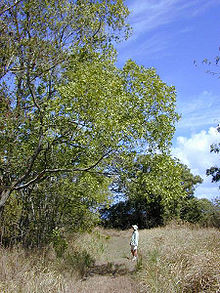Acacia auriculiformis
| Earleaf acacia | |
|---|---|
 |
|
| Scientific classification | |
| Kingdom: | Plantae |
| (unranked): | Angiosperms |
| (unranked): | Eudicots |
| (unranked): | Rosids |
| Order: | Fabales |
| Family: | Fabaceae |
| Genus: | Acacia |
| Species: | A. auriculiformis |
| Binomial name | |
|
Acacia auriculiformis A.Cunn. ex Benth. |
|
Acacia auriculiformis, commonly known as auri, earleaf acacia, earpod wattle, northern black wattle, Papuan wattle, and tan wattle, akashmoni in Bengali, is a fast-growing, crooked, gnarly tree in the family Fabaceae. It is native to Australia, Indonesia, and Papua New Guinea. It grows up to 30m tall.Acacia auriculiformis has about 47 000 seeds/kg.
Acacia auriculiformis is an evergreen tree that grows between to 15–30 m tall, with a trunk up to 12 m long and 50 cm in diameter. The trunk is crooked and the bark vertically fissured. Roots are shallow and spreading.
It has dense foliage with an open, spreading crown. Leaves 10–16 cm long and 1.5-2.5 cm wide with 3-8 parallel nerves, thick, leathery and curved.
Flowers are 8 cm long and in pairs, creamy yellow and sweet scented. Pods are about 6.5 x 1.5 cm, flat, cartilaginous, glaucous, transversely veined with undulate margins. They are initially straight but on maturity become twisted with irregular spirals. Seeds are transversely held in the pod, broadly ovate to elliptical, about 4-6 x 3–4 mm. At Kozhikode (Kerala, India), flocks of jungle crow (Corvus macrorhynchos), grey-headed myna (Sturnia malabarica) and red whiskered bulbul (Pycnonotus jocosus) have been observed to feed on the seeds with the aril that are exposed when the pods are split. These birds also probably help in dispersal of seeds.
The generic name acacia comes from the Greek word ‘akis’ meaning a point or a barb and the specific epithet comes from the Latin ‘auricula’- external ear of animals and ‘forma- form, figure or shape, in allusion to the shape of the pod.
Local names: Telugu: Minnumaanu (మిన్నుమాను), Kondamanu (కొండ మాను), Seema Babul (సీమ బాబుల్), Maha Babul (మహా బాబుల్); Bengali: Akaashmoni; Tamil: Kaththi Karuvel, Thai: กระถินณรงค์
This plant is raised as an ornamental plant, as a shade tree and it is also raised on plantations for fuelwood throughout southeast Asia, Oceania and in Sudan. Its wood is good for making paper, furniture and tools. It contains tannin useful in animal hide tanning. In India, its wood and charcoal are widely used for fuel. Gum from the tree is sold commercially, but it is said not to be as useful as gum arabic. The tree is used to make an analgesic by indigenous Australians. Extracts of Acacia auriculiformis heartwood inhibit fungi that attack wood.
...
Wikipedia

